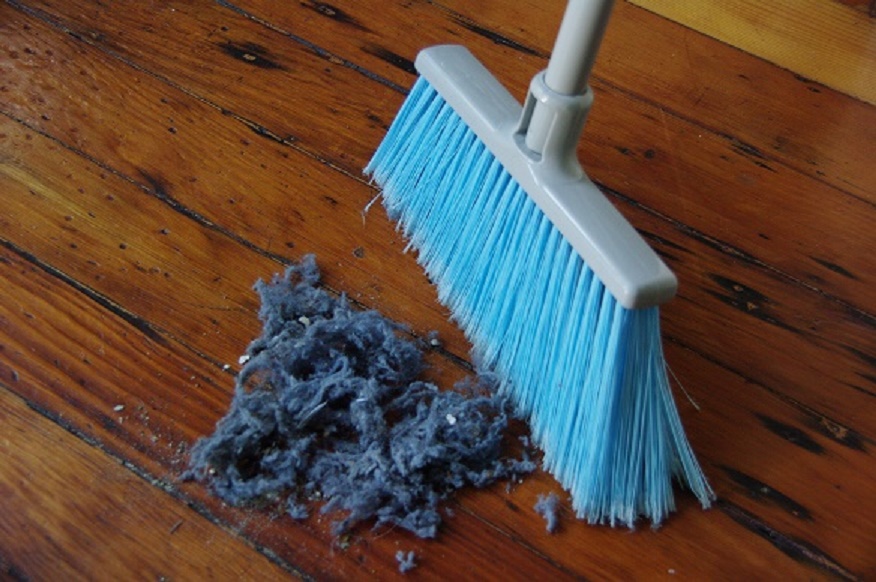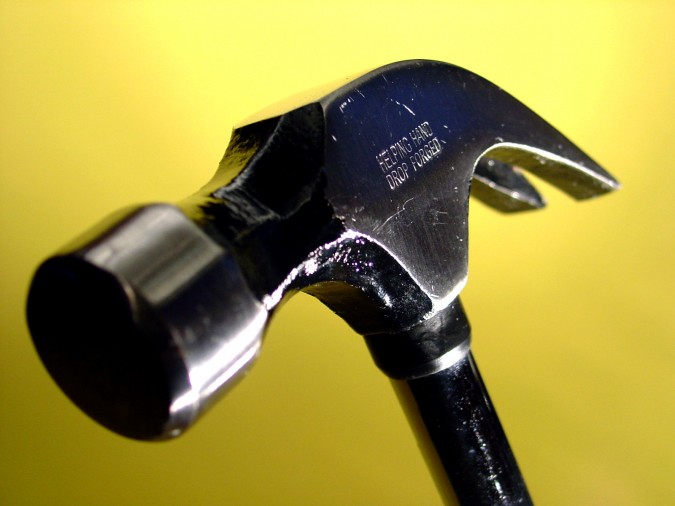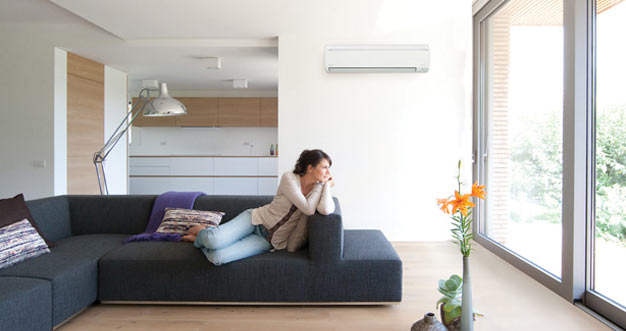leaves in fall and the brisk air in winter. Come spring and summer, though, it’s another matter entirely. Poor indoor air quality during this time of year can feel either humid and stuffy, or terribly stale. A lot of people will crack open a window to try to fix the situation. But there’s a much better (and more efficient!) way to address your stale air problems.
Why Does the Air Feel Stale?
Stale air is created in a number of different ways. Some of the most common causes are from lack of ventilation and various contaminants. The odors and allergens from commercial cleaning products and dust mites are a big no-no for fresh indoor air. But without a good filtration system in place, it’s hard to keep these issues at bay. They just keep adding up to create that lingering stale air vibe.
Another reason your air can feel stale is because of improper humidity levels. Over time, poor circulation can make your indoor air feel even more stuffy. You need to introduce fresh air into your home and workspace to keep them from turning into “stale and stagnant” environments. Fortunately, adjusting your indoor humidity and making sure your ventilation system is efficient and clean can go a long way. A little maintenance or a couple upgrades are usually all it takes to get clean indoor air every day of the year!
4 Ways to Fix Stale Air
There’s no sense to live with uncomfortable indoor air. In fact, those conditions can be a real problem for productivity. Multiple studies have shown that poor ventilation reduces cognitive functions. To feel your best, it’s important to breathe good, clean air. You can help get your indoor air quality up to par with these solutions—listed in order of Okay, Good, Better, and Best:
1. Open a window—but not for too long.
If you’re struggling with stale air, you can always open a few windows. Just remember, this won’t be a real long-term solution. For one, this can add a bunch of sticky humidity to your indoor air. Opening the windows can also let a whole bunch of allergens fly inside. Pollen, dust, and other unwelcome odors (the neighbor’s lawnmower exhaust, for example) can slip into your space without the right filtration. Then you’re stuck with a bunch of other problems! Plus, leaving your windows open while the AC is running can be real energy waste. The money spent on cooling your space then, essentially, just floats outside.
2. Turn on the fan.
Another option is to put a new air filter into your HVAC unit and turn on your ceiling fan. Better yet—put your thermostat on its “Fan Auto” setting! Then you can recirculate the air without introducing new allergens to the mix. The counterclockwise direction on your fan can help push the cool air down to keep the space feeling fresh. This setup can be a great “quick fix” to kick off the new season.
3. Change your air filter.
A better way to improve your air is to put in a new filter. This can allow your AC to work more efficiently. Remember: 4 to 5-inch media filters should be swapped out every 6-12 months, but 1-inch air filters should be changed every one to two months. If you live in an area that has lots of construction going on or fields being plowed, you might need to change your filter more often. Putting in a new filter every month, or even every couple week might be necessary depending on your conditions. If you haven’t checked yours in a while, it’s probably due for a change.
4. Invest in a new filtration system or dehumidifier.
The best way to fix stale air problems is to clean up your indoor air around the clock. Homes and office spaces that are tightly-sealed sometimes need special systems installed. The right HVAC equipment will work to improve your indoor air by cycling it with filtered air from outside. But you might also want a new air cleaner or an add-on unit to tackle humidity issues. If you’re sick of stale air, these are great upgrades to help you breathe easy. Talk with your local HVAC company to find the best energy-efficient system for your layout!
Schedule an Indoor Air Quality Review
For the ultimate spring cleaning, don’t forget about your indoor air quality. The air we breathe affects us every minute of every day, so it deserves special attention. Ventilation problems with older homes and buildings can definitely take a toll. These environments can even cause different health issues, including headaches, eye irritation, and coughing. Typically, these problems are grouped together and referred to as sick building syndrome. The same issues from poor ventilation can also show up in your home.
When changing your air filters and turning on the ceiling fan aren’t enough to fix your stale air problems, it’s time to call on your local indoor air quality professionals. A quick review of your existing ventilation can help determine any problems spots that need improving. An upgraded air cleaner, dehumidifier, or ventilation system might be all you need for a truly refreshing, healthy lifestyle! Contact LCS Heating and Cooling today to learn more.
March 21, 2018
That happy feeling when you take a deep breath of fresh air doesn’t only have to be an outdoor thing. Indoor spaces can get great air quality, too!
We use AC units and furnaces to correct our indoor comfort level, but cleanliness should be equally important. No one wants to breathe dust and mold and other funky smells wafting from your kitchen trash can. Luckily, some quick upgrades to your ductwork can help keep your air healthy.
How It Works: UV Air Purification Light
It kind of like sounds like a mouthful, but UV air purifiers aren’t as mysterious as they might seem. They’re basically special types of lights that work as air cleaners. These versions of ultraviolet rays are used to break up the cell structure of airborne contaminants and remove them from your indoor air. They work great against mold, mildew, and bacteria—plus all those weird home odors that scented candles won’t ever be able to remove.
Some UV lights (also called “germicidal lights”) will even work when your HVAC system isn’t running. This helps ensure that once it’s installed, you can expect an around-the-clock boost in your overall air quality. Because the UV light units are installed right in your ductwork, any air circulating through your system will get treated. And because they don’t have to be compatible with any particular air conditioner or furnace, they’re essentially a universal HVAC upgrade.
No matter what equipment you’re already using, a UV light can be a really smart add-on. They help keep your ductwork clean by killing mold—and yes, even fungi—which can even extend the life of your HVAC equipment and efficiency.
Types of UV Light Air Cleaners
No matter how new or old your home might be, airborne contaminants are always going to be an issue. Air cleaners help you stop the problem from getting worse and let you breathe air that’s nice and clean. Our two favorites are made by Lennox and APCO.
Lennox Healthy Climate UV Light
This air cleaner fights germs without putting any ozone into your home environment. (Other germicidal lights on the market can’t make the same claim.) The Lennox Healthy Climate UV light has also been shown to reduce airborne microorganisms by half, in just 45 minutes.
APCO Fresh-Aire UV Light
This model also reduces bacteria and viruses in your home, helping to eliminate odors for good. A special carbon cell in the APCO system captures the airborne contaminants. It also has a neat method for self-cleaning its inner coil to prevent mold growth.
These UV lights are also great solutions for smaller commercial properties. If your air at the office is a little “off,” you might consider getting one of these units installed. Fresh air can make a big difference in how relaxed and focused your feel throughout the day!
Seasonal Savings for UV Lights
From now until August 31, 2017, we’re offering our Indy-area homeowners a special discount on UV lights. It’s all part of our LCS Heating & Cooling Seasonal Special! We rotate these offers throughout the year to give you great savings on all kinds of home comfort products. Just reach out and schedule your installation before the end of August to get the discount—it’s valid for all new UV air purification light installs.
Any questions in the meantime? Be sure to give our offices a call at (317) 238-3961 or send a message through our Contact Us page. We’d be happy to schedule an in-home consultation to review your current setup and discuss these systems in more detail. Once you make the switch, you’ll be amazed at how refreshing your home's air can be!
July 31, 2017
People who suffer from seasonal allergies have been hit hard in 2017. Allergy symptoms flared up as early as February, and Indiana Public Media put the blame on our mild winter and early spring weather. So how do you get relief? Load up on allergy meds? Close yourself off to Mother Nature?
There’s no real clear-cut solution, but a lot of homeowners are getting help with whole-home purifiers. Air filters that work around the clock—and in every room—can actually be pretty effective against your toughest allergens.
Air Cleaners vs. Pollen
It would be awesome to have a magic wand that could take away all the pollen in your home. (We’d even be happy with one to get rid of dust!) Of course, this “magic solution” doesn’t exist. Pollen and allergens are part of life and the changing seasons. But having a whole-home air cleaner can help you manage the issues.
You see, the challenge with pollen is that the particles are a lot larger than other airborne contaminants. This means that any pollen from outside often settles in your home—on your bookshelf, couch, windowsill, you name it—before getting carried through to your air filter. But regular vacuuming, dusting, or just walking around your home can then stir these particles into the air again. The upside to this is having an in-duct particle removal system. Having the right air cleaner can help you remove those airborne pollen and dust particles, germs and bacteria, and even odors in your home’s air.
Benefits of Whole-Home Air Purifiers
Typically called whole-home purifiers, these units actually do a great job at removing larger airborne particles. The EPA even notes that high-efficiency filters are good at capturing pollen, dust, dust mites, animal dander, and certain molds.
The real benefit of whole-home air cleaners is that they help address air quality issues everywhere in your home. Unlike portable units, you’re not limited to one room. Because in-duct units connect right to your furnace, they’re able to treat the air as it cycles throughout your home. With these kinds of systems, it’s a lot easier to tackle tough air problems whenever they arise.
Lennox PureAirTM Systems
When it comes to indoor air purifiers, we love working with the Lennox PureAir systems for homeowners. Because they filter your air in multiple stages, you’re able to address the top three airborne issues in your home. This includes airborne particles, germs and bacteria, and chemical odors. These systems come with a lot of other perks, too:
- Whole-Home Application
- Reduces and destroys ozone
- Minimum Efficiency Reporting Value (MERV): MERV-16
- Compatible with all HVAC system types
- 5-Year Limited Warranty on covered components
The Lennox PureAir Cleaner also uses a carbon catalyst filter and UV bulbs. The UV light cleaners are key for these units because they kill bacteria and mold when the air passes through your system. You can even get a Lennox UV Light on its own—without the full PureAir system. The UV light installs directly on the furnace and goes to work right away.
All in all, air cleaners can offer some great benefits for homeowners who are serious about kicking their allergy issues and finding some relief. When your indoor air is regularly cleaned and fresh, it’s a lot easier to kick back and relax!
If you’ve been struggling with allergies this season or poor indoor air quality, give LCS a call. We’re always happy to consult with Indy-area homeowners on the best units for their lifestyle! Plus, we’ve got some great deals going for UV Air Purification Lights, available now through August 31, 2017.
April 28, 2017
Indoor air quality in winter can leave a lot to be desired. It’s easy to tell when our home’s temperature is too cold, but what about when the air gets too dry or dirty? Being cooped up inside can make us forget what clean air is actually like.
This time of year, it helps to check a few filters around your home. (That’s right—there’s more than just one air filter!) Get these areas cleaned up now, and you should be able to breathe easy until spring.
1. HVAC Air Filter
It’s important to replace your air filter consistently year-round, but this is even truer in the colder months. Furnaces get a lot of use in winter, and a dirty filter will only make it harder for your system to cycle air. Replacing your filter can help keep your HVAC unit from over-working itself.
Most homes that use 1" filters (and especially ones with pets) need to swap out their filters monthly. Homes with media filters (4"-5" filters) don't need to be changed as often, but should still be checked every 6 months. This helps prevent dust from clogging your system. So when the heat kicks in, your indoor air quality should be nice and fresh. Plus, clean filters can improve your unit’s efficiency in winter. You get cleaner air—and a lower energy bill.
2. Kitchen Range Hood Filter
For the home chefs out there, if this filter isn’t already on your cleaning rotation, add it now. This quick chore can help a lot with lingering food odors—especially in winter. Baking cookies is great, but we don’t want every smell from the kitchen to linger forever!
Cleaning these filter screens is pretty straightforward. You just find the screens under your range hood, pop them off, and wash them in your sink. Mix extra hot water with de-greasing dish soap and let the filters soak for 5-10 minutes. Then grab a plastic brush and start scrubbing. Rinse thoroughly, and let the filters air dry. They should only be re-installed when completely dry, so don't rush the process if they're even slightly wet. Once they’re squeaky clean, you should be able to save time by washing them monthly in the dishwasher.
3. Bathroom Exhaust Fan
The ventilation system in your bathroom also deserves some attention. While the fan may not have a “filter” in it per say, it still works to keep your home air clean. It draws out moisture and helps prevent mold and mildew from creeping around your shower space. Inspect the exhaust cover regularly to keep the airway clear.
To clean your bathroom vent, all you need is a vacuum with a dusting brush attachment. Make sure the fan is off (or flip the circuit breaker) and pull the vent fan cover down from the ceiling. There will probably be a couple clips holding the fan cover in place. Just move those aside to detach it. Then carefully vacuum around the fan and motor, and detail-clean the grille cover itself. Replace the cover, and you’re done!
If you have a whole house humidifier, there's an additional filter you need to check this season. Most whole home humidifiers have a filter pad that needs to be changed once a year. It can be easy to forget! But when you’re an Energy Savings Plan member with LCS Heating & Cooling, we can take care of the filter replacement for you. It’s an easy option to add to your annual maintenance visit.
For any other HVAC repairs or air quality issues you might have this winter, please don’t hesitate to contact us. We pride ourselves on our customer service and are always happy to help with your air quality and heating questions!
January 25, 2017
We know cold and flu season is right around the bend when the leaves fall and the temperatures drop. But before you start stocking up on tissues, take a minute to review your home. Research shows that your indoor environment can make a big impact on your seasonal influenza risks.
Chapped lips and static shocks are some of the first signs of having dry air indoors. Before long, other health concerns can flare up too. How we feel during the colder months is greatly influenced by our air quality at home. A healthy humidity level can go a long way in keeping your immune system strong.
Low Humidity Effects on Children
Here in Indiana, we usually view humidity as a nuisance. After dealing with high humidity levels in the summer, we often want to be rid of it during the colder months. In reality, having some humidity is healthy in the autumn and winter. It can be really hard for our bodies to feel at their best when indoor humidity levels drop below 40 or 30 percent. Without the right air system in place, these changes can be pretty intense—especially for infants and young children.
All around the world, seasonal changes in humidity tend to impact children more. Because their bodies are less effective at adapting to ambient humidity and other exposures, children are often more susceptible to humidity-related health issues. A recent review of 37 different studies revealed that humidity directly relates to “childhood asthma and other pediatric allergic diseases.” In countries and populations all over the globe, instances of relatively high humidity—and low humidity—both had an impact on children’s health.
It’s easy for kids to have health issues when moisture in the air isn’t quite balanced. One study in Greece showed a 31% increase in childhood asthma-related admissions during a 10% jump in humidity. Interestingly enough, the opposite also seems to be true. In Japan, emergency visits for childhood asthma increased when humidity levels had a rapid decrease. The same thing happened in Western Europe. Over there, children’s asthma symptoms spiked during the lowest monthly average of relative humidity. Not surprisingly, low humidity was also connected to eczema in Taiwanese schoolchildren. Dry skin, scratchy throats, and higher flu risks are all common side effects of low humidity levels.
Other Health Concerns with Dry Air
We’ve long understood that our skin gets irritated when exposed to dry air, but we sometimes forget that this happens indoors, as well as outside. Whenever humidity levels are low, dry air tends to draw out moisture from the nearest source. Typically, this is our bodies. Some people might feel that their eyes are dry or irritated, but it’s often our skin that takes the biggest hit. That’s often why we want to use so much lotion in the colder months. As the dry air pulls water from our skin, we think that using certain products will help our body retain its natural moisture. Of course, the underlying issue is humidity. Dry air also makes our nose and nasal passageways dry. For those already prone to asthma, this can make wintertime a real bummer.
One good thing about low humidity is that dust mites don’t do well in it. Unfortunately, this comes with its own set of problems. While indoor allergens might be lower in low humidity, our risk factor is significantly raised because our mucous membranes become dehydrated. The throat and nasal areas lose their natural barrier to airborne infections, and they’re unable to filter air like they normally do. All this puts us at higher risk for illness. So even if there aren’t lots of dust mites, the ones that are around are more likely to flare up allergies.
A dry upper respiratory tract also makes it more difficult to breathe comfortably. Some people experience nosebleeds in low humidity. Dry indoor air can also disrupt sleep and cause others to start snoring. Again—we tend to think of humidity as a bad thing in the hot and sticky summer months, but in the wintertime, a little humidity is a huge asset. Having some moisture in the air helps us breathe easier and makes it harder for airborne infections to migrate. The other problem with low humidity is that it makes areas feel colder than they really are. Without the moisture in the air, you might even be tempted to crank up the heat even higher—which only exacerbates the problem. You skin will just dry out even more in dry air, making you feel even worse.
Feeling Better with Indoor Humidity
The first step in feeling better in cold autumn days and through winter is to stay hydrated. The dry air outside will continue to affect your skin and respiratory system—even if your air indoors is at the proper humidity level. Drinking plenty of water shouldn’t stop just because the temperature drops. Of course, it’s fine to moisturize if you’re experiencing dry or itchy skin, but maintaining an indoor humidity level of 30 to 40 percent often seems to be the best fix. When your skin feels soft, you’ll be less likely to irritate it by scratching—this is something to watch for in little ones especially.
In order to keep a comfortable home humidity level year-round, a lot of families will opt to install a whole-home humidifier. These units are great because they work with your existing HVAC systems to deliver properly hydrated air throughout your home. That way, your humidity levels won’t fluctuate from room to room, and you can enjoy better sleep—free from dry air—in the colder months. Plus, they only turn on whenever your indoor humidity drops below a set level, so there’s no guess-work
In a lot of ways, these units are a no-brainer. Because they hook right up with your other air systems, you don’t even have to think about replacing parts or refilling reservoirs every day. They can help you breathe better and even give your body’s immune system a natural advantage during the typical “dry air” months. By protecting your respiratory system with the right humidity, you’ll be better able to ward off any illnesses that might be floating around this season—both for yourself and the ones you love.
November 15, 2016
Every home is going to encounter problems with dust—that’s just how life goes. Dust is all around us, so it’s only natural for it to collect on the shelves. There are some practical ways to reduce and remove dust week-to-week (more chores, anyone?), but you might consider a more permanent solution if you really want to keep the dust bunnies from creeping around. An effective home upgrade can help you cut back on dusting and give you the allergen-free air your home’s been missing out on.
Where Dust Comes From
Dust tends to fall into two categories: indoor dust and outdoor dust. The outdoor kind is easy enough to understand. It’s made of dry soil, bits of pollen floating in the air, and other tiny particles that sneak inside when we open and close the doors to our homes. An estimated two-thirds of dust originates from outdoor sources.
The components of indoor dust are a little more complicated. Little insect parts, pet dander, and our own skin flakes can become organic dust matter. Other ingredients include tiny pieces of fabric fibers. Carpeting and clothing decay whenever we use them, so they constantly add more dust material to the pile. That microscopic fluff then mixes with other outdoor dust particles that have snuck indoors to make our homes dusty and contaminate the air we breathe.
Dust and Our Health
House dust is well known for triggering asthma symptoms and it’s a primary source of other allergic reactions too. (Little wonder that indoor air pollution is one of the top 5 environmental health risks, right?) Sneezing, nasal congestion, runny noses, and itchy or red eyes are all common dust allergy symptoms. Even weekly vacuuming or changing your pillow case may not be enough to get relief.
Aside from being unsightly and allergenic, your home’s dust may also be carrying some nasty toxins. A lot of our modern products contain chemical flame retardants, or PBDEs. As furniture fabrics and other materials wear down, they essentially release those chemicals into our home. The Environmental Working Group suggests inspecting home goods that contain foam for any rips or any sign of breaking down to reduce the chance of toxic exposure. Products made between 1970 and 2005 are more likely to have PBDEs, and should probably be covered up or replaced.
Dust Allergy Management
While there’s no real way to completely rid a space of dust, there are some general, best practice tips for lowering the amount of dust in your home. The short-term solutions to reduce dust allergens often relate to household chores, like changing and washing bed linens weekly in hot water. Some homeowners may even decide to make the switch to hardwood floors to improve their chances of stopping indoor dust from carpet fibers. These are helpful tricks for dust mites, but we like to opt for a 24/7 solution when it comes to managing the dust and other allergens floating in our air.
When you’re ready to get serious about removing dust from your home, an indoor air cleaner is definitely the way to go. These purification units can tackle the three different types of air pollution: airborne particles, like dust; germs and bacteria; and chemical vapors, or other strong odors. Filtration options are available as portable units (if you just want one for a single room) as well as whole-house systems.
A lot of families go with a whole-house system because it makes sure your air is clean before it starts circulating throughout your home. They essentially work to remove everything you don’t want to breathe. Once a unit is hooked up, you can cut out about 90% of all airborne mold and bacteria indoors. That leads to safer, cleaner air for allergen-prone individuals too. Pet dander, pollen, dirt and dust mites have a whopping 95% reduction rate with whole-house filter. These systems are super-effective!
If you’re concerned about other indoor air issues in your home, you can always check out this neat solutions guide from Lennox. Just click on the options that match what’s going on in your home to learn more. When you’ve got an air cleaner that’s right for your home, dirty air goes in and only fresh air comes out. There’s no way to completely stop dust from ever collecting, but a good air unit can definitely help you cut back on dusting so much. They’re a great solution for clean home air and easy, allergen-free breathing.
August 23, 2016
People will sometimes associate their indoor air quality with things like scented candles, carpet refreshers, and fragrance plug-ins. We all want to live in homes that don’t “smell bad,” but those scented store products won’t actually take care of any air problems. According to the EPA, the level of air pollutants we’re exposed to indoors is often five times higher than any outdoor pollutant levels, so it’s especially important that our indoor air is properly filtered. Forget the fancy perfumes—if you want a clean and fresh-smelling home, the key is that it shouldn’t smell like anything!
When you’re looking to get your house smelling better, your filtration system is a good first line of defense. It catches dust and other particles in the air to keep your home’s ventilation system from blowing extra contaminants throughout. Replacing your filters regularly will help boost your home’s air quality, but if you really want to neutralize odors, you’ll need more than a good air filter.
In order to tackle the allergens and mold in their indoor air, a lot of homeowners end up adding a UV light to their whole-home filtration system. Think of these lights as special, powerful air cleaners. The UV unit tackles air quality problems that are too complicated for your filter—things like odors and pathogens. We like installing the APCO UV light because it doesn’t create any ozone indoors as it attacks the mold, airborne bacteria and viruses, and odors in your air. The light filters your air by transforming the contaminants into CO2 and water vapor. And with the air contaminants eliminated, you get an unscented home!
The “unscented” part of home air quality is key. A filter can help with dust, but addressing any lingering smells requires a more advanced system, like a UV light. We don’t want the cat’s litter box, stale smoke, pungent cleaning solutions, that fresh coat of paint, or the smell of last night’s dinner wafting into our bedrooms (no matter how delicious it was). Air solutions that truly neutralize odors won’t just mask other smells, they’ll eliminate them. And they won’t leave any scent behind either. That’s the whole point of a UV filter—it takes care of the air pollutants that a filter can’t handle alone.
Independent studies from an allergy testing lab have proven that our go-to UV light removes microbes and VOCs and other air pollutants in your home, but the APCO manufacturer has other perks too. We already mentioned it’s ozone-free. Another bonus is that the APCO’s carbon cells don’t ever get dirty in the air purification process. Unlike other electronic air filters, this one doesn’t have parts that need to be cleaned or replaced every month or two. There’s even a lifetime warranty on the unit itself, plus it has a 2-year bulb rather than just a 1-year bulb like
most other UV units.
By effectively removing airborne pathogens like mold, bacteria, viruses, and other smelly odors, this special kind of filtration helps you get fresh air circulating in your home every day. UV systems are easy to uninstall too—so if you ever end up moving, you can take your current system with you and keep that good air flowing at your new address!
A great UV light keeps your home smelling nice and neutral. If you have any questions about the right type of filtration system for you home, please give us a call or leave us a message below. For the best air quality, unscented is definitely the way to go!
March 23, 2016
It can be so difficult to feel cozy in winter when there’s freezing cold air outside and harsh, dry air inside. If your skin is dry or itchy, or it seems like you’re getting shocked every day in your home, you’re probably suffering from low humidity.
Fortunately, a humidifier can offer an easy fix. A lot of homeowners use a whole house humidifier to keep dry air away and get their home’s humidity levels between 30 and 45 percent. Regulating your indoor air does wonders for creating a comfy-cozy home during the cold months. Once you’ve got one of these systems installed, you’ll wonder how you ever made it through winter without it!
5 Reasons Why Homeowners Love Whole House Humidifiers:
1. Helps prevent disease and offers allergy relief.
Having some moisture in the air is actually good for breathing. It helps your body block dust, dirt, or bacteria and viruses from entering your lungs and making you sick. The right humidity levels in your home will help protect your respiratory and immune system, whereas dry air just makes it harder for us to stay healthy.
We don’t usually think of having allergies in winter, but dust mites and other indoor allergens like pet hair are still around every season. And because our indoor air gets drier when we turn our heaters on, these allergens have easier ways of spreading. Boosting your air moisture to the right levels can prevent those irritating particles from getting into your lungs. The right humidity levels help keep your body’s natural defenses strong.
2. Keeps skin soft and helps with chapped lips.
Low humidity will attack your skin and dry it out, and flaky, itchy, or rough skin are sure signs of dry air in your home. In extreme cases, your skin may even crack or show symptoms of eczema.
Installing a humidifier helps your skin stay hydrated year-round. A whole house humidifier improves your air quality and gives you a comfortable air moisture level all throughout your home so you don’t have to apply lotion multiple times a day. With good home humidity levels you’ll notice your lips are better protected in winter too.
3. Protects hardwood floors, door jambs, and furniture.
Just like your skin, your wood furnishings can start to crack with dry air. When humidity levels are too low, the air in your home will try to find moisture wherever it can—which means your hardwood floors, walls, door jambs, furniture, and even your piano are at risk of drying out, shifting, or splitting.
Preventing dry skin is great, but proper humidity levels also go a long way in maintaining the structure of your home. This can be one of the most costly problems related to dry air. Think of it this way: A whole house humidifier not only helps protect every room in your home, but also everything in it!
4. Stops annoying static!
Static electricity goes wild in dry air, and it’s easy to get shocked in winter with low humidity. Returning some moisture to your home’s air helps keep static from building up. There a lot of bizarre tricks (like putting a safety pin on your shirt collar!) you can try to remove static electric in your home, but getting a humidifier is your best bet.
It’s a lot harder to get shocked when your humidity is in check. Whole house humidifiers keep humidity levels at a comfortable 30 to 45 percent in winter. When they’re up and running, you don’t have to be shy about petting your cat or dog, brushing your hair, or giving someone a hug—the static shouldn’t bother you anymore.
5. Lets you breathe better and sleep easier.
Dry air can lead to dry throats, dry coughs, and even nose bleeds. A lot of homeowners find extra health benefits in their sleep with a whole home humidifier.
Nasal passages can feel irritated when humidity levels are too low in winter, but regulating moisture with a humidifier can help you feel better both day and night! A whole home humidifier can often improve your breathing and sleep schedule because you’re less likely to wake up with a dry cough or sore throat when your air moisture is at a comfortable level.
For more information about whole house humidifiers, check out our quick humidifier video on YouTube and other “How To” clips on our video page. There’s no reason to stay static-y in winter! If you’re ready to be done with dry air for good, reach out to your local heating and cooling experts to find a humidifier that’s right for your home.
February 18, 2016
Wreck or Protect? How Water Affects Your Appliances
A guest blog article by: Indy Soft Water
We all want to get the most out of our home appliances, but one of the biggest ways to prevent repairs (outside of regular maintenance services) is something so simple, we often forget it—our water! The kind of water you use in your home goes a long way in either wrecking or protecting your water-using appliances. Without the right water systems in place, you’re making your appliances age a whole lot faster.
Tap water in Indiana is notoriously “hard.” This means that it has high levels of dissolved minerals that can damage your appliances. While these minerals are naturally-occurring (calcium and magnesium compounds get picked up from rocks during the water cycle), hard water is a real nuisance around the home.
These are some of the top symptoms of hard water:
- Water Spots on your “clean” dishes
- Crusty Buildup on your shower head and around your faucets
- White Film inside your tea kettle or pots after boiling water
- Soap Scum in your sinks or around the bathtub
Hard water leaves minerals behind when it evaporates from your dishes and bathroom fixtures. Unfortunately, it also leaves these deposits in places you can’t see—like in all in the intricate parts of your appliances. These deposits build in rock-hard layers called “lime scale.”
The inner workings of your dishwasher, laundry machine, water heater, and humidifier all fall victim to lime scale buildup when your home uses hard water. Your water heater is particularly vulnerable against hard water. Sediments and lime scale build up on the bottom of your heater and on other internal parts. With too much hard water sediment at its base, your water heater can overheat, damage its electrical parts, and basically render the system useless by reducing capacity and efficiency. Because the scale is heated first, rather than the water, your system ends up wasting energy and your water won’t get as hot as it should be. All the more reason to get preventative maintenance services scheduled!
Similar hard water problems can occur with a whole-house humidifier, too. As more and more minerals pile up on your system they’ll interfere with how well your humidifier functions by plugging the solenoid valve, that open/close device that allows water to flow. Keeping a clean humidifier—and water heater—has a lot to do with using water that’s “soft,” instead of hard water.
This is why people love soft water:
- Spot-free dishes
- Hair feels smoother
- No more mineral buildup
- Soap lathers and rinses better
- Longer lifespan for water-using appliances
- And the list goes on...
A lot of homeowners choose to install a water softener system because it removes the minerals in hard water and helps protect their major home appliances from getting sediment buildup. Like the name suggests, when you have a softener in place, your home’s water becomes wonderfully “soft!”
Got any questions about whether a water softener is right for you? Check out the Indy Soft Water website, send us a message, or call 31-228-9822. We’ve been your local water experts since 1964, and we’re always happy to chat!
Indy Soft Water is proud to serve the following Indiana areas: Carmel, Fishers, Greenwood, Indianapolis, Noblesville, Westfield, and Zionsville.
November 30, 2015
The last thing on anyone's mind right now is HVAC. It's too warm to need the furnace and too cool to need the air conditioner. We do live in Indiana though so that can change in just 24 hours! We want to provide some tips for things you can do on your own to keep your furnace and air conditioner running at its best. We present the LCS Top Ten of Homeowner DIY HVAC Tips:
10. During cold or hot months, keep the programmable thermostat set within 3 degrees of each setting. A furnace and air conditioner will have to run for a very long time to make up the temperature difference. If you have an electric furnace
and heat pump, the electric furnace will come on as well to reach the set temperature. Since an electric furnace runs at a higher cost, it counters the savings that you might have had with the lower initial temperature.
9. Keep the weed eater and lawn mower away from the control wiring of the air conditioner. The wiring should not be hanging down but if it is, be careful when mowing and weed eating. It's not a high voltage wire but if it gets cut with a weed eater or mower, you can get shocked and it can take out the air conditioner. If the wiring is loose or hanging down, tie it up with electrical tape or have a technician tie it back when they're out doing annual maintenance.
8. If you are experiencing high utility bills, call the gas or electric company first. Ask the utility company if there's been an increase in the therm or electric rate. Ask if your bill compares to the average of others in your neighborhood. You can get great information about what your utility bill should be running. If there isn't a good reason for the higher bill, then it might be time to have a technician out to make sure the system is operating properly.
7. Move furniture away from registers. It's not uncommon to see a couch over a register or a bookcase pushed up against a register. Not only can the heat dry out your furniture but it also prevents the air from properly traveling throughout the rooms.
6. Keep registers open. A very common problem in two story homes is a temperature swing between the upstairs and downstairs. Homeowners try to fix this problem by closing registers upstairs or in some rooms. Keep the registers open. Closing registers can restrict air flow and cause the furnace to run hot. This can ultimately shorten the life of parts inside the furnace such as motors. It can also make the air conditioner freeze up by reducing the volume of air that the system needs to expel throughout the house. This is comparable to running the system with a dirty filter.
5. If you notice a noise, smell or problem, call on it right away. If you notice something unusual, don't ignore it. It's rare that an HVAC issue will go away or resolve itself. Noises and smells often mean that a part is getting weak or going out. A little critter could also have gotten inside. Address these issues before your furnace or air conditioner goes completely out. It's no fun being without heat on a cold day or without a/c when it's hot out!
4. Keep dogs away from the air conditioner. Animal urine will degrade the a/c fins. There's not much that can be done to fix the fins once this happens so it's best to make sure the fur babies stay away.
3. Replace the batteries in the thermostat. If the thermostat goes blank, check to see if there are batteries that need changed. Not all thermostats have batteries, but if it does, it's likely AA or AAA batteries that need changed.
2. Pick up leaves that are around the air conditioner or heat pump. Leaves, cottonwood, branches, etc can gather around the air conditioner. Keep these things cleaned away so the outdoor unit can breathe.
1. CHANGE THE FILTER! This is the number one thing to do to keep your furnace and air conditioner running efficiently! A dirty filter causes restricted air flow and can ultimately cause the system to stop working. If you have a 1" filter, check it once a month. If you have a 4-5" filter, check it every 3 months. It may not need to be changed at that time but it's good to check it to make sure. It's also a good idea to keep extra filters at the house. That way, you always have one on hand when it's time for it to be changed.
A couple of other tips are to caulk or re-caulk around windows and doors. It's also a great idea to check the insulation in your home. If you don't have at least 12-15" of insulation in the attic, you'll want to consider adding more!
Keeping up on these things can not only save you money but can save you from the inconvenience of being without heating or cooling during those hot and cold months. HVAC equipment is definitely an investment. Protect your investment by following our Top Ten tips!
April 23, 2015










